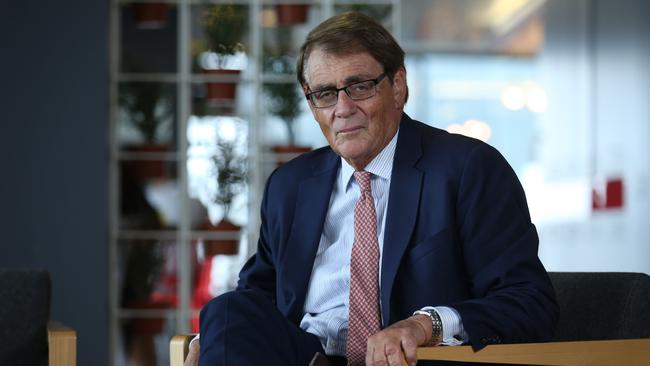RBA’s interest rates time frame has reached expiry date: Bill Evans
The RBA must allow for interest rate hikes before 2024 but a fragile recovery means it will push back against expectations of as many as four interest rate hikes in 2022.

Higher than expected inflation and stronger-than-expected economic data should see the Reserve Bank tweak its policies to allow for interest rate rises before 2024 — but a fragile recovery means it will push back against expectations of as many as four rate increases next year.
But the time was right for the central bank to discard its calendar-based monetary policy guidance, Westpac chief economist, Bill Evans, said ahead of the RBA board’s decision at 2.30pm AEDT on Tuesday. While Mr Evans expected the RBA to keep the cash rate at 10 basis points until February 2023, he predicted a significant upward revision of economic forecasts, such that the central bank’s guidance that its inflation precondition would not be met before 2024 would be inconsistent with the forecasts.
After surging last week after the central bank declined to defend its April 2024 bond yield target of 10 basis points despite a massive overshoot of its target after higher than expected CPI data, bond yields fell sharply on Monday amid last-minute caution before the RBA meeting.
The April 2024 bond yield slipped to 71 basis points after hitting 81 on Friday, while three-year and 10-year bond yields fell about 20 basis points, to 1.1 per cent and 1.91 per cent respectively.
The S&P/ASX 200 index partly recovered from Friday’s bond yield-related fall.
The dollar stayed buoyant above US75c despite expectations the US Federal Reserve would announce a “taper” of its pandemic era pace of asset purchases, currently at $US120bn ($160bn) a month.
Westpac’s Mr Evans said it would be “appropriate” for the RBA to “exclude the 2024 guidance”.
In that case it was “unlikely that the unconventional approach of setting a date would be retained”.
While the existing guidance underpinned confidence in the RBA’s commitment to do everything reasonably within its powers to protect the economy during the coronavirus pandemic, “setting specific dates has not been a standard policy in previous cycles”, he noted.
“Now that the emergency has passed; the economy is reopening; and there are early signs that the board may be closer to achieving its objectives, the time is right to move away from such a rigid policy approach,” Mr Evans said.
If the “2024 guidance” were removed, he saw no point keeping an April 2024 bond-yield target that reinforced that guidance. Nominating an earlier period for the lifting of the cash rate and an associated yield curve target for a shorter bond would also be “highly unlikely”.
A “lift-off date” for the cash rate was “part of a set of emergency measures” that did not need to be perpetuated given a “normalisation of economic conditions” and “positive economic outlook”.
“Now that those uncertainties have passed the time is right to move back to a standard approach of not setting specific dates for the policy outlook or needing to emphasise the strength of that commitment with the yield curve control targeting policy,” Mr Evans said.
A rise in bond yields last week became “unmoored”, with a “yawning chasm between the RBA’s previous view of the likely time for the next rate hike and market pricing”, according to Commonwealth Bank.
“Markets seemed to come to the view that even if the RBA does abandon the yield curve target on Tuesday as seems nearly certain, they may keep a more elongated timeframe for the next rate hike,” CBA senior fixed income strategist Philip Brown said.
“But there’s still plenty of scope for the April 2024 [bond] to sell off if the RBA does end yield-curve targeting.”
GSFM investment strategist Stephen Miller said the RBA had underestimated inflation and its persistence, and needed to jettison its “emergency” monetary settings and wrap up its bond buying.
“The RBA should acknowledge that it will jettison what it has described as ‘emergency’ monetary policy settings and that it should have contemplated that action earlier and perhaps should have thought about and communicated the circumstances where it would have done so,” he said.
Mr Miller warned that more persistent inflation had been visible for some time globally.
Domestically, high vaccination rates and the end of lockdowns meant the case for emergency monetary policy settings was “rapidly and clearly diminishing, particularly given the mounting costs of those settings in terms of inflating financial and real estate assets and the resultant financial stability concerns, not to mention the exacerbation of wealth inequality,” Mr Miller said.
That should see the RBA retreat from, or abandon, its view that the condition for a cash rate rise “will not be met before 2024”, confirm the market’s assumption that it has scrapped its April 2024 bond yield target of 10 basis points and end its bond buying in the first half of 2022. But in his view, these policy decisions were more “tactical”.
A bigger question was whether to keep “outcomes-based forward guidance”, which may unnecessarily constrain the central bank to act “only when the inflation genie is effectively out of the bottle”.
Pandemic-induced supply shocks are coinciding with a reversal of some structural causes of deflation over the past three decades: globalisation of labour supply and baby-boomer workforce participation, plus the secular rise in female workforce participation, which caused a massive global labour supply shock and a decline in wage growth and a structural deflationary trend.
Unemployment may stay relatively high because of geographic or skill mismatch.
“Keeping the monetary ‘pedal to the metal’ in these circumstances simply promotes inflation without any benefit to the unemployment rate,” Mr Miller said. “Put simply, monetary policy can’t do much about structural rigidities that lead to unemployment.”








To join the conversation, please log in. Don't have an account? Register
Join the conversation, you are commenting as Logout